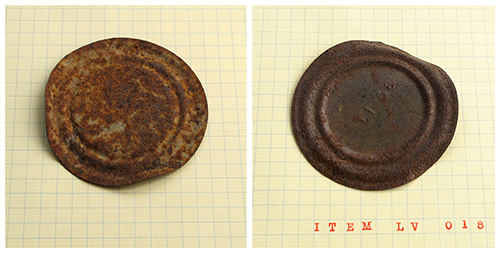 These are two sides of the same dented lid. Its weathered surfaces suggest that it was exposed to the elements for many years. Otherwise, the lid's story remains something of a mystery. I'll venture a guess, though. I imagine that the lid sealed a can of rations that Robert F. Scott's ill-fated Terra Nova Expedition took to the South Pole. Upon reaching their destination on 17 January 1912, they pitched tent and popped open the can. The lid, tossed to the side, rolled out of the shelter's unsecured entryway onto the polar plateau. Propelled by frigid gusts, the disc raced across the ice for days, following the landscape's contours and glaciers. Navigating the Trans-Antarctic mountain range and the Dry Valleys in a final descent towards the open sea, the lid suddenly encountered a fierce blizzard that drove it into a shallow pond, abruptly ending its voyage. For decades it hung suspended in the watery void, surrounded by microscopic creatures. The organisms on one side of the disc increasingly came to regard it as the sun, while the microbes on the other side increasingly saw it as the moon. Eventually it ceased to be an object at all; it was simply two ideas. Or at least that's the way I imagine it. This and the last three Antarctic Items I featured were generously donated to the Long View project by "Crunch" Noring, the Marble Point camp manager. He retrieved them from the grounds of his Dry Valleys camp, home to numerous remnants from the pre-Code of Conduct era.
These are two sides of the same dented lid. Its weathered surfaces suggest that it was exposed to the elements for many years. Otherwise, the lid's story remains something of a mystery. I'll venture a guess, though. I imagine that the lid sealed a can of rations that Robert F. Scott's ill-fated Terra Nova Expedition took to the South Pole. Upon reaching their destination on 17 January 1912, they pitched tent and popped open the can. The lid, tossed to the side, rolled out of the shelter's unsecured entryway onto the polar plateau. Propelled by frigid gusts, the disc raced across the ice for days, following the landscape's contours and glaciers. Navigating the Trans-Antarctic mountain range and the Dry Valleys in a final descent towards the open sea, the lid suddenly encountered a fierce blizzard that drove it into a shallow pond, abruptly ending its voyage. For decades it hung suspended in the watery void, surrounded by microscopic creatures. The organisms on one side of the disc increasingly came to regard it as the sun, while the microbes on the other side increasingly saw it as the moon. Eventually it ceased to be an object at all; it was simply two ideas. Or at least that's the way I imagine it. This and the last three Antarctic Items I featured were generously donated to the Long View project by "Crunch" Noring, the Marble Point camp manager. He retrieved them from the grounds of his Dry Valleys camp, home to numerous remnants from the pre-Code of Conduct era.